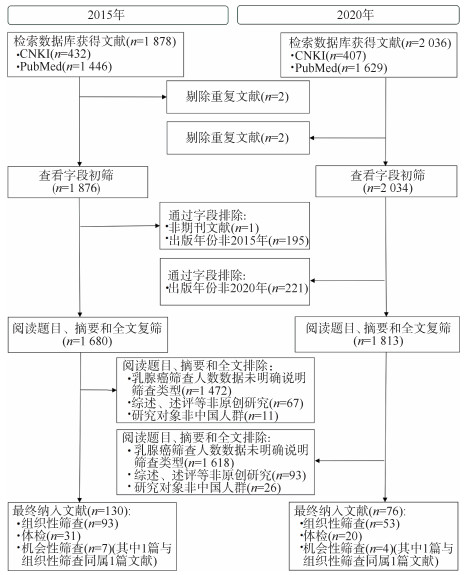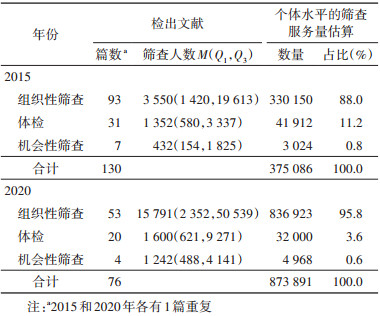文章信息
- 王鑫, 李燕婕, 雷林, 吴宇洁, 赵方辉, 石菊芳.
- Wang Xin, Li Yanjie, Lei Lin, Wu Yujie, Zhao Fanghui, Shi Jufang
- 中国适龄女性乳腺癌筛查服务的可及性——筛查率及其构成分析
- Access to breast cancer screening among females in China: a focus report on screening rate and composition
- 中华流行病学杂志, 2023, 44(8): 1302-1308
- Chinese Journal of Epidemiology, 2023, 44(8): 1302-1308
- http://dx.doi.org/10.3760/cma.j.cn112338-20230103-00001
-
文章历史
收稿日期: 2023-01-03
2. 深圳市慢性病防治中心肿瘤防控科, 深圳 518020;
3. 国家癌症中心/国家肿瘤临床医学研究中心/中国医学科学院北京协和医学院肿瘤医院流行病学研究室, 北京 100021
2. Department of Cancer Prevention and Control, Shenzhen Center for Chronic Disease Control, Shenzhen 518020, China;
3. Department of Cancer Epidemiology, National Cancer Center/National Clinical Research Center for Cancer/Cancer Hospital, Chinese Academy of Medical Sciences & Peking Union Medical College, Beijing 100021, China
乳腺癌目前是全球女性发病人数较多的癌种[1],且近年在中国的发病率、死亡率和伤残调整寿命年负担均呈上升趋势[2-3],而筛查是降低癌症死亡率的有效途径之一[4-5]。中国于2009年和2012年先后启动了两项国家重大公共卫生服务项目——农村女性“两癌”(乳腺癌、宫颈癌)检查项目(两癌筛查项目)[6]和城市癌症早诊早治项目[7]。其中两癌筛查项目于2019年又被纳入了国家基本公共卫生服务项目[8],2021年版《乳腺癌筛查工作方案》显示,两癌筛查项目的服务对象范围由以往的仅农村适龄女性扩大至城乡适龄女性[9]。此外,在多项重要规划文件中,均制定了乳腺癌筛查相关覆盖率和筛查率的工作目标,如《中国妇女发展纲要(2011-2020年)》提出“2020年妇女常见病定期筛查率达到80%以上,扩大宫颈癌、乳腺癌检查覆盖范围”[10],《中国妇女发展纲要(2021-2030年)》提出2030年“乳腺癌人群筛查率逐步提高”[11],《健康中国行动(2019-2030年)》提出到2022年和2030年农村适龄妇女“两癌”筛查县覆盖率应≥80%和≥90%[12]。
卫生服务可及性当前在国际范围内日益受到关注[13-14],其广泛应用于卫生政策评估领域。国际癌症研究署在其系列癌症筛查手册中对筛查技术和方案效果的综合评价中,将筛查覆盖率等可获得性指标列为主要评价指标之一[15-16]。两癌筛查项目在2021年版工作方案中,也将乳腺癌筛查率列为筛查绩效考核指标[9]。当前开展的乳腺癌筛查相关研究多关注于效果评价和技术评估[17-19]。有研究报告筛查覆盖率、筛查率、检出率等分析指标[20-22],但多为地方性报道。已有研究报道了全国性乳腺癌筛查率信息[包括国家卫生服务调查和中国CDC“慢性病监测系统”相关数据(中国慢性病及其危险因素监测于2014年更名为中国成人慢性病与营养监测[23],更名前后乳腺癌筛查率的调查方法未变,故此处和后文统称为“慢性病监测系统”)][24-27],但目前未见乳腺癌筛查覆盖率数据。同时,当前中国乳腺癌筛查为组织性筛查(指社区或单位实体借助医疗保健机构的设备、技术和人员有组织地为适龄女性提供乳腺筛查服务)、机会性筛查(指医疗保健机构为因各种情况前来就诊的适龄女性进行的乳腺筛查,或女性个体主动或自愿到提供乳腺筛查的医疗保健机构进行检查)[28]、体检等多类型并存[29],但不同筛查服务类型的实际占比未见系统报道。了解不同筛查服务类型的构成占比,有助于提供针对性的方向引导,为加快实现提高乳腺癌筛查服务可及性的总目标提供证据。因此本研究旨在系统整合中国适龄女性乳腺癌筛查覆盖率和筛查率,分析其时间趋势和不同筛查服务类型的构成。
资料与方法1. 方法概括:首先,基于核心文献、相关官方网站、项目或调查报告等,摘录整合并分析既往全国性调查中女性乳腺癌筛查覆盖率和筛查率数据,对40~69岁及35~64岁组筛查率进行标化和比较。为了解其内部不同服务类型(组织性筛查、体检及机会性筛查)的构成情况,采用文献综述法检索,以涉及相关筛查服务类型的检出文献量、单篇筛查人数等为权重,估算筛查服务类型的构成。通常筛查的类型主要包括组织性筛查和机会性筛查;后者包含体检,但鉴于体检是目标人群主动寻求筛查服务的特殊性,且近年体检人数增幅明显[30],故本研究在对乳腺癌筛查内部构成分析时将体检作为独立类型。
此外,筛查覆盖率和筛查率的概念在现有报道中存在交叉[9, 15, 21, 31]。筛查覆盖率多指一定地区范围的适龄女性在推荐筛查间隔期间,实际接收到乳腺癌筛查邀请的女性所占比例[15],该概念反映的是具有筛查需要的人是否有获得筛查服务的机会,更关乎本土政策和卫生公平;相关概念还有筛查区/县覆盖率等[8]。目前报道较多的筛查率(也有报道为“筛查参与率”[27, 32-33])多指一定地区范围的适龄女性在推荐筛查间隔期间,实际接受过乳腺癌筛查的女性所占比例[9, 15],该指标反映的是筛查服务的实际利用程度,更关乎个体的行为意识等因素[34-35];如,若某范围人群的全部适龄女性可享受免费(政府付费)的乳腺癌筛查服务,实际筛查率可能有高低差别,但筛查覆盖率可认为是100%。
2. 乳腺癌筛查覆盖率分析:系统检索2010年1月1日(两癌筛查项目启动后第一年)至2022年11月30日中国知网(CNKI)、万方数据知识服务平台和PubMed文献库中有关乳腺癌筛查覆盖率的期刊文献。检索限定在题目和摘要中,采取主题词和自由词相结合的方法。中文检索词为“乳腺癌”“乳腺肿瘤”“筛查”“普查”及“覆盖率”等;英文检索词为“breast neoplasms”“breast cancer”“breast tumor”“screening”“mass screening”“coverage”等。纳入标准:公开发表的期刊文献、乳腺癌筛查覆盖率为全国性数据、研究对象为中国人群、语种为中文或英文;排除标准:重复研究(仅纳入1次)、在标题或摘要中出现乳腺癌筛查覆盖率但全文内容与之不相关的、地方性报道、非原创性研究。检索初获文献53篇(中文39篇,英文14篇),经去重、阅读题目和摘要后均予以排除,未见符合标准的中国乳腺癌筛查覆盖率文献。
3. 乳腺癌筛查率分析:通过前期所了解的全国性乳腺癌筛查率的文献报道[26-27],手动检索相关专题及团队(国家卫生服务调查、“慢性病监测系统”)在PubMed、CNKI、万方数据知识服务平台中2010年至今发表的其他乳腺癌筛查相关文献进行补充。对于最终确定的核心文献,摘录其所属调查及开展时间、筛查率及年龄、问卷注释定义等。为使来自不同横断面调查的特定年龄段(如40~69岁——国内筛查指南推荐筛查年龄[36])的筛查率更可比,本研究采用直接标化法以2010年普查人口为标准人口进行标化[37]。
4. 乳腺癌筛查内部构成分析:
(1)检索策略:采用文献综述法,基于CNKI和PubMed两个中外代表性文献库,时间选择2015年1月1日至12月31日,限定在题目和摘要中,采取主题词和自由词结合的方法进行检索。中文检索词为“筛查”“普查”“体检”“早诊早治”等和“乳腺癌”“乳腺肿瘤”“乳腺癌癌前病变”等;英文检索词为“mass screening” “physical examination”“early diagnosis”等和“breast neoplasms”“breast cancer”“breast tumor”等。为了解国家政策对筛查内部构成的影响及近年构成情况,同时囿于工作量及篇幅,选择将两癌筛查项目纳入基本公共卫生服务项目后的2020年平行检索比较。
(2)文献纳入标准:公开发表的期刊文献、研究内容与乳腺癌3种筛查类型相关、研究对象为中国人群、研究筛查人数报告明确可靠、语种为中文或英文。排除标准:重复研究(仅纳入1次)、乳腺癌筛查人数数据未明确说明筛查类型(排除以较少筛查人数的体检人群作为对照的病例对照研究类文献)、综述、述评等非原创性研究及动物实验。
(3)文献处理:对于最终纳入的文献,阅读文题、摘要或全文,摘录筛查类型、研究设计、筛查人数等建库。分析3种筛查类型的文献检出量和单篇研究筛查人数中位数,基于3种筛查类型(组织性筛查、体检及机会性筛查)开展数量与最终文献发表数量等比例的假设,以文献检出量和单篇研究筛查人数中位数相乘结果作为3种筛查类型个体服务量的估算值,并分别计算其占个体水平的筛查服务总量的构成比。
结果1. 中国乳腺癌筛查人群覆盖率和筛查率:经检索未见全国乳腺癌筛查覆盖率相关报道。乳腺癌筛查率的全国性报道确认6处核心文献来源,关键信息:①来源及年份:包括国家卫生服务调查报告2次[24-25](2013、2018年),基于中国CDC的“慢性病监测系统”调查报道4次(调查起始年份为2010年与2013年各1次,2015年2次)[26-27, 32-33]。②抽样方法:6次抽样方式均为多阶段分层整群随机抽样,国家卫生服务调查以东、中、西地区和城乡为标识分层,“慢性病监测系统”调查从全国抽取部分区/县或检测点,二者均细化至乡镇/街道、村/居委会和住户单位。③原始调查问卷核心问题设置以及原文注释定义或分析指标:两个调查来源的调查问卷对乳腺癌筛查率的问询方式不同,国家卫生服务调查问询20~64岁女性“近12个月内,您是否做过乳腺检查?”,其中“乳腺检查”指妇女健康体检(常见病筛查)中以乳腺癌筛查为目的的乳房检查,包括医生体检、超声检查和X线钼靶检查。可能无法排除孕育哺乳高峰年龄女性的乳腺炎等体检服务,报道的1年内检查率更高(2013年为26.5%,2018年为28.3%;对应“慢性病监测系统”调查≥20岁女性的1年内筛查率为14.2%)[24-25, 27];对应地,“慢性病监测系统”调查的原始调查设置明确为“您是否曾经接受过乳腺癌筛查?如果接受过,最近一次检查是在什么时候?”;后者执行定义更接近本次分析研究目的,故选择其作为本研究主要信息源。④筛查率:“慢性病监测系统”对乳腺癌筛查率报告的指标有既往(所有年份)、3年内、2年内和1年内乳腺癌筛查率,主要是根据调查当日回忆是否曾经接受过乳腺癌筛查以及最近一次的时间问询分析得到[26-27, 32-33]。其中报道最多的是既往筛查率[26-27, 32-33]和2年内筛查率[27, 32],1年内筛查率有1篇[27];另有1篇区分了是否有过筛查干预区/县的率[33]。“慢性病监测系统”系列报道的最近调查年份是2015年,对其调查数据进行年龄标化后的分析提示,中国40~69岁女性2015年1年内、2年内、3年内乳腺癌筛查率分别为16.9%、20.2%(对应2010年率值为16.9%)和21.4%。乳腺癌既往筛查率的数据报道较多,对40~69岁女性乳腺癌筛查率标化后提示,2010、2013和2015年的既往筛查率依次为24.9%、21.1%和23.5%。2013年35~64岁女性的乳腺癌既往筛查率为23.3%,2015年为25.7%。有关不同调查来源中不同时段的乳腺筛查率的原始报告值和对筛查年龄段的年龄标化率的更多信息见表 1。
2. 乳腺癌筛查内部构成结果:由于本研究重点分析了2015年的全国调查数据[27],因此应用文献综述方法进行的筛查服务内部构成分析主要基于2015年的发表文献,同时以2020年数据为对照参考。2015年初检获文献1 878篇,逐层筛选最终纳入130篇,筛选流程见图 1。组织性筛查、体检及机会性筛查的筛查人数M(Q1,Q3)分别为3 550(1 420,19 613)、1 352(580,3 337)和432(154,1 825)。以3种服务报道中位筛查人数结合检出篇数,估算组织性筛查、体检和机会性筛查占个体服务总量的比例分别为88.0%、11.2%和0.8%。同时,2020年初检获文献2 036篇,逐层筛选最终纳入76篇。以相同方法估算2020年组织性筛查、体检和机会性筛查占个体服务总量的比例分别为95.8%、3.6%和0.6%。见表 2。

|
| 注:CNKI:中国知网 图 1 不同乳腺癌筛查类型文献的筛选流程及结果 |
本研究以筛查覆盖率和筛查率为核心指标,对乳腺癌筛查服务在中国女性的可及性进行了探讨。该数值预期在2019年乳腺癌筛查纳入国家基本公共卫生服务项目后提升幅度更明显。文献综述分析初步提供了中国当下乳腺癌筛查服务类型的构成数据,当前仍以组织性筛查为主体,但受发表偏倚等影响,组织性筛查服务实际占比是否更低尚不确定。此外,对中国适龄女性乳腺癌筛查覆盖率的精确估算仍是难点。
全国性调查数据显示,中国女性的乳腺癌筛查率经过年龄标化后有波动,可能与横断面调查相关偏倚有关。证据可获得性层面,呈现1年内、2年内、3年内和既往的乳腺癌筛查率,利用相对稳定的执行定义指标进行连续监测和报告,是对中国乳腺癌筛查服务利用和可及性及时监测评估的有效信息保障。
乳腺癌筛查干预复杂且资源密集[38],其他国家模式可供参考。英国2018年3年内乳腺癌筛查率为75.9%[39],约为中国2015年的3倍,可能原因是英国早在1988年便启动了覆盖全国的乳腺癌筛查项目[15];韩国和日本也分别在1999年和1987年启动了覆盖全国的乳腺癌筛查项目[15, 40-41],两国乳腺癌筛查率也较高,但项目运行组织层面的不同可能导致了两国筛查效果的区别[40],如韩国2015年乳腺癌既往筛查率为61.2%[42],日本2019年2年内乳腺癌筛查率为47.4%[43];南非2012年乳腺癌既往筛查率为13.4%[44],印度2015-2016年的一项全国性调查显示,女性中只有9.7%接受过乳腺检查[45],筛查率均较低,这可能与两国目前均无覆盖全国的乳腺癌筛查项目,乳腺癌筛查以机会性筛查或试点为主有关[15, 38]。可见筛查覆盖的广度可能与筛查率的高低密切相关。
本研究存在局限性。①核心文献及文献综述检索过程可能存在漏检,部分原始文献对不同率的概念应用有交叉混淆,数据摘录过程虽予以辨别但仍可能错分。②筛查率数据趋势分析来自多个横断面,整合分析可能受到原有偏倚更大影响。③细节数据可获得性是最大难点,其中构成分析结果可能受发表偏倚影响;也因调查与发表时间滞后而无法获得更新数据。
今后乳腺癌防控实践中,应进一步重点推进政府主导的筛查计划,同时辅以体检、机会性筛查等形式,实现多渠道发力并加快扩大乳腺癌筛查覆盖面,以达到提高乳腺癌筛查服务可及性、最终防控疾病的目标。
利益冲突所有作者声明无利益冲突
作者贡献声明
利益冲突 所有作者声明无利益冲突
作者贡献声明 王鑫:研究设计、数据整理、统计学分析、论文撰写;李燕婕、雷林、吴宇洁:数据整理、论文修改:赵方辉:研究指导、论文修改;石菊芳:研究设计/指导、论文修改、经费支持
| [1] |
Sung H, Ferlay J, Siegel RL, et al. Global cancer statistics 2020: GLOBOCAN estimates of incidence and mortality worldwide for 36 cancers in 185 countries[J]. CA A Cancer J Clin, 2021, 71(3): 209-249. DOI:10.3322/CAAC.21660 |
| [2] |
Zheng RS, Zhang SW, Zeng HM, et al. Cancer incidence and mortality in China, 2016[J]. J Natl Cancer Center, 2022, 2(1): 1-9. DOI:10.1016/j.jncc.2022.02.002 |
| [3] |
Yan XX, Zhu J, Li YJ, et al. Estimating disability-adjusted life years for breast cancer and the impact of screening in female populations in China, 2015-2030: an exploratory prevalence-based analysis applying local weights[J]. Popul Health Metr, 2022, 20(1): 19. DOI:10.1186/s12963-022-00296-1 |
| [4] |
Ilbawi AM, Anderson BO. Cancer in global health: how do prevention and early detection strategies relate?[J]. Sci Transl Med, 2015, 7(278): 278 cm1. DOI:10.1126/scitranslmed.3008853 |
| [5] |
Siegel RL, Miller KD, Fuchs HE, et al. Cancer statistics, 2021[J]. CA A Cancer J Clin, 2021, 71(1): 7-33. DOI:10.3322/CAAC.21654 |
| [6] |
Di J, Rutherford S, Chu C. Review of the cervical Cancer burden and population-based cervical Cancer screening in China[J]. Asian Pac J Cancer Prev, 2015, 16: 7401-7407. DOI:10.7314/apjcp.2015.16.17.7401 |
| [7] |
国家卫生健康委员会办公厅. 关于印发«城市癌症早诊早治项目管理办法(试行)»的通知[EB/OL]. (2012-10-26)[2022-11-14]. http://www.nhc.gov.cn/wjw/gfxwj/201304/02a18d0954d845e5bb48cf6817beb8dc.shtml.
|
| [8] |
国家卫生健康委员会, 财政部, 国家中医药管理局. 关于做好2019年基本公共卫生服务项目工作的通知[EB/OL](2019-09-04)[2022-11-14]. http://www.nhc.gov.cn/jws/s7881/201909/83012210b4564f26a163408599072379.shtml.
|
| [9] |
国家卫生健康委员会妇幼健康司. 乳腺癌筛查工作方案[EB/OL]. (2021-12-31)[2022-11-14]. http://www.nhc.gov.cn/fys/s3581/202201/cad44d88acca4ae49e12dab9176ae21c/files/8bb19eea375f4edf80d9d01a1030d053.pdf.
|
| [10] |
国务院. 国务院关于印发中国妇女发展纲要和中国儿童发展纲要的通知[EB/OL]. (2011-07-31)[2022-11-14]. http://www.gov.cn/gongbao/content/2011/content_1927200.htm.
|
| [11] |
国务院. 国务院关于印发中国妇女发展纲要和中国儿童发展纲要的通知[EB/OL]. (2021-09-27)[2022-11-14]. http://www.gov.cn/zhengce/content/2021-09/27/content_5639412.htm.
|
| [12] |
健康中国行动推进委员会. 健康中国行动(2019-2030年)[EB/OL]. (2019-07-09)[2022-11-14]. http://www.nhc.gov.cn/guihuaxxs/s3585u/201907/e9275fb95d5b4295be8308415d4cd1b2.shtml?from=timeline&isappinstalled=0.
|
| [13] |
GBD 2016 Healthcare Access and Quality Collaborators. Measuring performance on the Healthcare Access and Quality Index for 195 countries and territories and selected subnational locations: a systematic analysis from the Global Burden of Disease Study 2016[J]. Lancet, 2018, 391(10136): 2236-2271. DOI:10.1016/S0140-6736(18)30994-2 |
| [14] |
Sirohi B, Mathew A. Access to and affordability of cancer medicines: time to focus on the last mile[J]. Lancet Oncol, 2021, 22(10): 1342-1343. DOI:10.1016/S1470-2045(21)00518-0 |
| [15] |
IARC. Breast cancer screening. IARC handbooks of cancer prevention[EB/OL]. (2016)[2022-11-06]. https://publications.iarc.fr/Book-And-Report-Series/Iarc-Handbooks-of-Cancer-Prevention/Breast-Cancer-Screening-2016.
|
| [16] |
IARC. Colorectal cancer screening. IARC handbooks of cancer prevention[EB/OL]. (2019)[2022-11-06]. https://publications.iarc.fr/Book-And-Report-Series/Iarc-Handbooks-Of-Cancer-Prevention/Colorectal-Cancer-Screening-2019.
|
| [17] |
Wang Y, Feng YQ, Zhang L, et al. Deep adversarial domain adaptation for breast cancer screening from mammograms[J]. Med Image Anal, 2021, 73: 102147. DOI:10.1016/j.media.2021.102147 |
| [18] |
Liu JQ, Zhao HQ, Huang YK, et al. Genome-wide cell-free DNA methylation analyses improve accuracy of non-invasive diagnostic imaging for early-stage breast cancer[J]. Mol Cancer, 2021, 20(1): 36. DOI:10.1186/s12943-021-01330-w |
| [19] |
马兰, 连臻强, 赵艳霞, 等. 基于1 501 753名中国农村妇女乳腺癌筛查的乳腺超声优化流程分析[J]. 中华肿瘤杂志, 2021, 43(4): 497-503. DOI:10.3760/cma.j.cn112152-20190828-00549 Ma L, Lian ZQ, Zhao YX, et al. Breast ultrasound optimization process analysis based on breast cancer screening for 1 501 753 rural women in China[J]. Chin J Oncol, 2021, 43(4): 497-503. DOI:10.3760/cma.j.cn112152-20190828-00549 |
| [20] |
Sun YJ, Ma YH, Cao MH, et al. Breast and cervical cancer screening adherence in Jiangsu, China: An ecological perspective[J]. Front Public Health, 2022, 10: 967495. DOI:10.3389/fpubh.2022.967495 |
| [21] |
魏巍, 张妍, 张月, 等. 2011至2020年北京市妇女乳腺癌筛查状况分析[J]. 中国妇幼健康研究, 2022, 33(12): 101-107. DOI:10.3969/j.issn.1673-5293.2022.12.018 Wei W, Zhang Y, Zhang Y, et al. Analysis of breast cancer screening results among women in Beijing from 2011 to 2020[J]. Chin J Woman Child Health Res, 2022, 33(12): 101-107. DOI:10.3969/j.issn.1673-5293.2022.12.018 |
| [22] |
廖先珍, 颜仕鹏, 石菊芳, 等. 城市女性乳腺癌高危评估及筛查结果分析[J]. 实用肿瘤学杂志, 2016, 30(3): 245-248. DOI:10.11904/j.issn.1002-3070.2016.03.010 Liao XZ, Yan SP, Shi JF, et al. Breast cancer risk assessment and results analysis of clinical screening in urban women[J]. Pract Oncol J, 2016, 30(3): 245-248. DOI:10.11904/j.issn.1002-3070.2016.03.010 |
| [23] |
中国疾病预防控制中心. 中国成人慢性病与营养监测(2015)第一期预调查圆满完成[EB/OL]. (2015-05-01)[2022-11-08]. https://www.chinacdc.cn/zxdt/201505/t20150501_114351.html.
|
| [24] |
国家卫生健康委员会统计信息中心. 2013第五次国家卫生服务调查分析报告[EB/OL] (2016-10-26)[2022-10-21]. http://www.nhc.gov.cn/mohwsbwstjxxzx/s8561/201610/9f109ff40e9346fca76dd82cecf419ce.shtml.
|
| [25] |
国家卫生健康委员会统计信息中心. 2018年全国第六次卫生服务统计调查报告[M]. 北京: 人民卫生出版社, 2021. Statistical Information Center of the National Health Commission. An analysis report of national health services survey in China, 2018[M]. Beijing: People's Medical Publishing House, 2021. |
| [26] |
包鹤龄, 王临虹, 王丽敏, 等. 中国2013年35~69岁女性子宫颈癌和乳腺癌筛查率及影响因素研究[J]. 中华流行病学杂志, 2018, 39(2): 208-212. DOI:10.3760/cma.j.issn.0254-6450.2018.02.014 Bao HL, Wang LH, Wang LM, et al. Study on the coverage of cervical and breast cancer screening among women aged 35-69 years and related impact of socioeconomic factors in China, 2013[J]. Chin J Epidemiol, 2018, 39(2): 208-212. DOI:10.3760/cma.j.issn.0254-6450.2018.02.014 |
| [27] |
Zhang M, Zhong YJ, Bao HL, et al. Breast cancer screening rates among women aged 20 years and above-China, 2015[J]. China CDC Wkly, 2021, 3(13): 267-273. DOI:10.46234/ccdcw2021.078 |
| [28] |
中国抗癌协会乳腺癌专业委员会. 中国抗癌协会乳腺癌诊治指南与规范(2021年版)[J]. 中国癌症杂志, 2021, 31(10): 954-1040. DOI:10.19401/j.cnki.1007-3639.2021.10.013 CACA-CBCS, Chinese Anti-Cancer Association, Committee of Breast Cancer Society. Guidelines and Specifications for breast cancer Diagnosis and Treatment of China Anti Cancer Association (2021)[J]. Chin Oncol, 2021, 31(10): 954-1040. DOI:10.19401/j.cnki.1007-3639.2021.10.013 |
| [29] |
国家卫生健康委员会. 关于政协十三届全国委员会第四次会议第4952号(医疗体育类620号)提案答复的函[EB/OL]. (2022-01-20)[2022-11-14]. http://www.nhc.gov.cn/wjw/tia/202201/e31b4cc26c1f4e3aa9b6aa94e8a54911.shtml.
|
| [30] |
国家卫生健康委员会. 中国卫生健康统计年鉴-2021[M]. 北京: 中国协和医科大学出版社, 2021. National Health Commission of the People's Republic of China. China Health Statistics Yearbook (2021)[M]. Beijing: Peking Union Medical College Press, 2021. |
| [31] |
Muratov S, Canelo-Aybar C, Tarride JE, et al. Monitoring and evaluation of breast cancer screening programmes: selecting candidate performance indicators[J]. BMC Cancer, 2020, 20(1): 795. DOI:10.1186/s12885-020-07289-z |
| [32] |
Wang BH, He MF, Wang LM, et al. Breast cancer screening among adult women in China, 2010[J]. Prev Chronic Dis, 2013, 10: 130136. DOI:10.5888/pcd10.130136 |
| [33] |
Bao HL, Wang LM, Brown M, et al. A nationally quasi-experimental study to assess the impact of partial organized breast and cervical cancer screening programme on participation and inequalities[J]. BMC Cancer, 2020, 20(1): 1191. DOI:10.1186/S12885-020-07686-4 |
| [34] |
Han HN, Wang XY, Zhu YM, et al. Organized breast and cervical cancer screening: attendance and determinants in rural China[J]. Int J Environ Res Public Health, 2022, 19(14): 8237. DOI:10.3390/ijerph19148237 |
| [35] |
石菊芳, 曹梦迪, 严鑫鑫, 等. 肝癌筛查在我国人群中的可及性: 一项探索性分析[J]. 中华流行病学杂志, 2022, 43(6): 906-914. DOI:10.3760/cma.j.cn112338-20211112-00879 Shi JF, Cao MD, Yan XX, et al. Access to liver cancer screening and surveillance in populations in China: an exploratory analysis[J]. Chin J Epidemiol, 2022, 43(6): 906-914. DOI:10.3760/cma.j.cn112338-20211112-00879 |
| [36] |
赫捷, 陈万青, 李霓, 等. 中国女性乳腺癌筛查与早诊早治指南(2021, 北京)[J]. 中华肿瘤杂志, 2021, 43(4): 357-382. DOI:10.3760/cma.j.cn112152-20210119-00061 He J, Chen WQ, Li N, et al. China guideline for the screening and early detection of female breast cancer (2021, Beijing)[J]. Chin J Oncol, 2021, 43(4): 357-382. DOI:10.3760/cma.j.cn112152-20210119-00061 |
| [37] |
胡楠, 姜勇, 李镒冲, 等. 2010年中国慢病监测数据加权方法[J]. 中国卫生统计, 2012, 29(3): 424-426. DOI:10.3969/j.issn.1002-3674.2012.03.045 Hu N, Jiang Y, Li YC, et al. Data weighting methods for China chronic disease surveillance (2010)[J]. Chin J Health Stat, 2012, 29(3): 424-426. DOI:10.3969/j.issn.1002-3674.2012.03.045 |
| [38] |
Basu P, Zhang L, Hariprasad R, et al. A pragmatic approach to tackle the rising burden of breast cancer through prevention & early detection in countries 'in transition'[J]. Indian J Med Res, 2020, 152(4): 343-355. DOI:10.4103/IJMR.IJMR_1868_19 |
| [39] |
NHS Cancer Screening Programmes. Breast screening programme, England provisional statistics 2017-18[EB/OL]. (2018-12-20)[2022-11-20]. https://digital.nhs.uk/data-and-information/publications/statistical/breast-screening-programme/england---provisional-statistics-2017-18.
|
| [40] |
Goto R, Hamashima C, Mun S, et al. Why screening rates vary between Korea and Japan-differences between two national healthcare systems[J]. Asian Pac J Cancer Prev, 2015, 16(2): 395-400. DOI:10.7314/apjcp.2015.16.2.395 |
| [41] |
Hamashima C, Japanese Research Group for the Development of Breast Cancer Screening Guidelines, Hamashima CC, et al. The Japanese guidelines for breast cancer screening[J]. Jpn J Clin Oncol, 2016, 46(5): 482-492. DOI:10.1093/jjco/hyw008 |
| [42] |
Choi E, Lee YY, Suh M, et al. Socioeconomic inequalities in cervical and breast cancer screening among women in Korea, 2005-2015[J]. Yonsei Med J, 2018, 59(9): 1026-1033. DOI:10.3349/ymj.2018.59.9.1026 |
| [43] |
Ministry of Health, Labor and Welfare of Japan. Summary of the basic Survey of National Life in 2019: 3. The health status of family members[EB/OL]. [2022-11-20]. https://www.mhlw.go.jp/toukei/saikin/hw/k-tyosa/k-tyosa19/dl/04.pdf.
|
| [44] |
Phaswana-Mafuya N, Peltzer K. Breast and cervical cancer screening prevalence and associated factors among women in the south African general population[J]. Asian Pac J Cancer Prev, 2018, 19(6): 1465-1470. DOI:10.22034/APJCP.2018.19.6.1465 |
| [45] |
Negi J, Nambiar D. Intersectional social-economic inequalities in breast cancer screening in India: analysis of the national family health survey[J]. BMC Womens Health, 2021, 21(1): 324. DOI:10.1186/s12905-021-01464-5 |
 2023, Vol. 44
2023, Vol. 44




